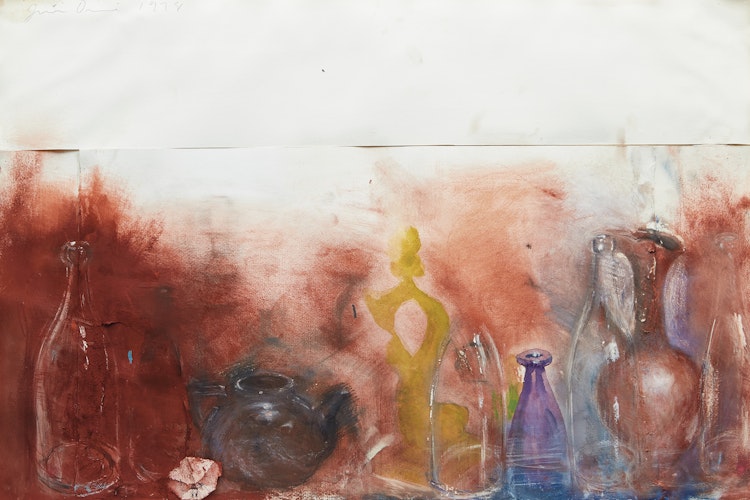Untitled Still Life by Jim Dine

Jim Dine
Untitled Still Life
mixed media on paper
signed and dated 1978 upper left; titled and dated on two gallery labels on the reverse
27 x 40.5 ins ( 68.6 x 102.9 cms ) ( sheet )
Auction Estimate: $10,000.00 - $15,000.00
Price Realized $15,600.00
Sale date: June 8th 2023
Provenance:
The Pace Gallery, New York
Gloria Luria Gallery, Florida
Private Collection, Toronto
The Pace Gallery, New York
Gloria Luria Gallery, Florida
Private Collection, Toronto
Literature:
Giorgio de Chirico, Giorgio Morandi, London, 1970
Jim Dine, “Jim Dine: Painting What One Is”, New York, 1981, page 206
Giorgio de Chirico, Giorgio Morandi, London, 1970
Jim Dine, “Jim Dine: Painting What One Is”, New York, 1981, page 206
The oeuvre of the American artist Jim Dine, born in 1935, extends over sixty years and has contributed to the emergence of Performance Art and Pop Art. Following his studies in poetry at the University of Cincinnati, Dine received his BFA in 1957 from the University of Ohio. During the late 1950s, he would visit New York City every month to immerse himself in the art of Willem de Kooning, the collages of Robert Motherwell, and the combines of Robert Rauschenberg.
As Dine matured as an artist, however, he would begin lamenting the fact that modern artists now preferred painting to drawing: “[what] everyone thinks is great freedom is a lack of draughtsmanship.” While drawing might have been perceived as a simpler means of expression by his contemporaries, Dine excelled at it, being able to swiftly represent any given object, from bottles to skulls, pots and vases. Here the artist has depicted glassware assembled on a tabletop. The picture is simultaneously deliberate and uncanny, with the vases set in a row against a brown ground that seemingly merges with the background. The juxtaposition of translucent and coloured glassware, in various shapes and sizes, further suggests that Dine’s assemblages, like this one, were encyclopedic rather than merely naturalistic in scope.
Dine’s still lifes ultimately pay tribute to the Italian artist Giorgio Morandi, who is best known today for his arrangements of bottles, vases and jugs in a sombre palette. The words that Giorgio de Chirico used to describe Morandi can, arguably, also apply to Dine’s own art:
“He looks at a collection of objects on a table with the same emotions that stirred the heart of the traveler in ancient Greece […] In this way he has contributed to […] the metaphysics of the common object. However much we may be aware that appearances deceive, we often look at familiar things with the eyes of one who sees and does not know.”
As Dine matured as an artist, however, he would begin lamenting the fact that modern artists now preferred painting to drawing: “[what] everyone thinks is great freedom is a lack of draughtsmanship.” While drawing might have been perceived as a simpler means of expression by his contemporaries, Dine excelled at it, being able to swiftly represent any given object, from bottles to skulls, pots and vases. Here the artist has depicted glassware assembled on a tabletop. The picture is simultaneously deliberate and uncanny, with the vases set in a row against a brown ground that seemingly merges with the background. The juxtaposition of translucent and coloured glassware, in various shapes and sizes, further suggests that Dine’s assemblages, like this one, were encyclopedic rather than merely naturalistic in scope.
Dine’s still lifes ultimately pay tribute to the Italian artist Giorgio Morandi, who is best known today for his arrangements of bottles, vases and jugs in a sombre palette. The words that Giorgio de Chirico used to describe Morandi can, arguably, also apply to Dine’s own art:
“He looks at a collection of objects on a table with the same emotions that stirred the heart of the traveler in ancient Greece […] In this way he has contributed to […] the metaphysics of the common object. However much we may be aware that appearances deceive, we often look at familiar things with the eyes of one who sees and does not know.”
Share this item with your friends

